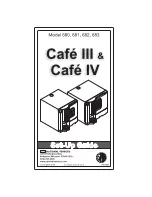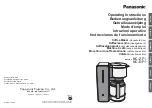
30
25CI400A/W • 25HI400A • 50CI400A/W • 50HI400A
Refrigeration system
Important:
All service on refrigeration system must
be performed in accordance with all federal, state and
local laws that pertain to the use of refrigerants. It is
the responsibility of the technician to ensure that these
requirements are met.
CAUTION
• Recharging of unit at other than factory specifi cations will
void icemaker warranty
Icemaker charge specifi cations
Model
Charge
Refrigerant
Type
25/50CI400A, 25/50HI400A
20 oz
R404A
25/50CI400W
9 oz
R404A
Refrigerant replacement requirements
1. Non-contaminated refrigerant removed from any
Follett refrigeration system can be recycled and
returned to the same system after completing
repairs. Recycled refrigerant must be stored in a
clean, approved storage container. If additional
refrigerant is required, virgin or reclaimed
refrigerant that meets ARI standard 700-88 must be
used.
2. In the event of system contamination (for example,
a compressor burn out, refrigerant leak, presence
of non-condensibles or moisture), the system must
be repaired, evacuated and recharged using virgin
or reclaimed refrigerant that meets ARI standard
700-88.
3. Follett Corporation does not approve of recovered
refrigerants. Improper refrigeration servicing
procedures will void the factory warranty.
Evacuation
Evacuate the system to a level of 500 microns. When
the 500 micron level is reached, close valves and shut
down the vacuum pump. Allow the system to sit for
approximately 20 minutes. During this period the system
pressure should not rise. If the system pressure rises
and stabilizes there is moisture in the system and further
evacuation is needed. If the pressure continues to rise
check the system for leaks.
Ambients
Air Temperature
1
Minimum
Maximum
Fahrenheit
50 F
100 F
Celsius
10 C
38 C
Water Temperature
2
Minimum
Maximum
Fahrenheit
40 F
90 F
Celsius
4 C
32 C
1 - Ambient air temperature is measured at the air-cooled condenser coil inlet.
2 - Ambient water temperature is measured in the icemaker fl oat reservoir.
Refrigeration data
Ice production
F
C
50
10
60
16
70
21
80
27
90
32
60
16
425
193
410
186
395
180
380
173
365
166
70
21
395
180
380
173
365
166
350
159
335
152
80
27
360
164
345
157
330
150
318
145
305
139
90
32
330
150
315
143
300
137
285
130
273
124
100
38
295
134
285
130
270
123
255
116
243
111
lbs.
kg.
lbs.
kg.
lbs.
kg.
lbs.
kg.
lbs.
kg.
Inlet W
a
ter
T
emper
atur
e
˚F/˚C
Ambient Air Temperature F/C
Air-cooled icemaker capacity/24 hrs.
Inlet W
a
ter
T
emper
atur
e
˚F/˚C
F
C
50
10
60
16
70
21
80
27
90
32
60
16
430
195
415
188
401
182
385
175
368
167
70
21
425
193
406
184
386
175
365
166
343
156
80
27
418
190
392
178
365
166
340
154
315
143
90
32
390
177
368
167
345
156
323
147
300
136
100
38
350
159
334
152
318
144
304
138
290
132
lbs.
kg.
lbs.
kg.
lbs.
kg.
lbs.
kg.
lbs.
kg.
Ambient Air Temperature F/C
Water-cooled icemaker capacity/24 hrs.
Ice capacity test
Icemaker production capacity can only be determined by
weighing ice produced in a specifi c time period.
1. Remove top panel and hopper lid of unit.
2. Weigh and record weight of container used to
catch ice.
3. Run icemaker for at least 15 minutes.
4. Catch ice for 15 or 20 minutes.
5. Weigh harvested ice and record total weight.
6. Subtract weight of container from total weight.
7. Convert fractions of pounds to decimal equivalents
(Ex. 6 lbs 8 oz = 6.5 lbs).
8. Calculate production using following formula:
1440 min. × wt. of ice produced
=
production capacity/
24 hr. period
Total test time in minutes
9. Calculated amount per 24 hours should be checked
against rated capacity for same ambient and water
temperatures in Ice Production Table (above).
Compressor current draw
Air-Cooled Ambient Air Temperature
Fahrenheit
60 F
70 F
80 F
90 F
100 F
Celsius
15.6 C
21.1 C
26.7 C
32.2 C
37.8 C
Locked Rotor Amps
58.8
Gearmotor data
Gearmotor current
2.25A (nominal)
Locked Rotor Amps
14 amps
















































